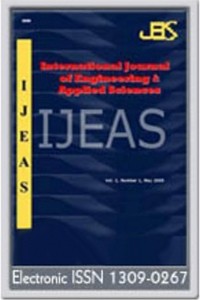OPTIMIZATION OF SOME PARAMETERS OF HIGH TENSION ROLL SEPARATOR TO RECOVER TITANIFERROUS PLACER MINERALS
In this study, a three-level Box-Behnken factorial design combined with response surface methodology (RSM) for modeling and optimizing of some process parameter of high tension roll separator for the separation of titanium bearing minerals (ilmenite and rutile) was developed. The three significant operational parameters of HTRS, which were feed temperature, feed rate and roll speed, were varied and the results evaluated with the Box-Behnken factorial design, Response Surface Methodology and also Quadratic Programming (QP). Second-order response functions were produced for grade and recovery and separation efficiency of the titanium bearing minerals in the conducting fraction. Taking advantage of the quadratic programming, it is observed that maximum grade of 98.76 % can be achieved at 123 rpm roll speed, 40 kg/h feed rate and 140˚C temperature. Maximum recovery of 99.06 % can be achieved at 180 rpm, 60 kg/h feed rate and 140˚C temperature. Similarly, maximum separation efficiency of 98.81% can be achieved at 120 rpm, 51.6 kg/h and 140 ˚C temperature using QP technique. Predicted values of responsesobtained using model equations were in good agreement with the experimental values (R value of 0.98 for grade, R2 value of 0.97 for recovery and R2 value of 0.93 for separation efficiency)
Keywords:
Box-Behnken design, response surface methodology optimization, high tension roll separator, titanium bearing minerals,
___
- [1] T. Laxmi and R.Bhima Rao, Bad land topography of coastal belt sediment deposits of India: A potential resource for industrial minerals, Mines and Minerals Reporter, Vol. 3, No. 7, 2010, pp-12-18.
- [2] J. Elder and E. Yan, Force, Newest generation of electrostatic separator for the minerals sands industry, Heavy Minerals Conference, Southern African Institute of Mining and Metallurgy, Johannesburg, 2003.
- [3] M. Germain, T Lawson, D Henderson, D MacHunter, The application of new design concepts in high tension electrostatic separation to the processing of mineral sand concentrates, “Heavy Minerals Conference 2003” Capetown, 2003.
- [4] D.M.Hopstock, An analysis of a rotating-drum-type electrostatic separator, PhD Thesis, University of Minnesota, 1972.
- [5] R.D. Morrison, Mathematical modelling of high tension roll separation, PhD Thesis, University of Queensland, 1977.
- [6] A.D. Dance, R.D. Morrison, Quantifying a black art: the electrostatic separation of mineral sands, Minerals Engineering, Vol. 5, 1992, pp-751– 765.
- [7] M. Ziemski and P.N Holtham, Particle bed charge decay behavior under high tension roll separation, Minerals Engineering, Vol.18, 2005, pp-1405-1411.
- [8] P. De Waal and F. E. Du Plessis, Automatic control of a high tension roll separator, Heavy Minerals Conference, Florida, Society for Mining, Metallurgy, and Exploration, 2005, pp. 241–249.
- [9] S. A. Ravishankar and H. Kolla, Chemically enhanced electrostatic separation, The 7th International Heavy minerals Conference, Southern African Institute of Mining and Metallurgy, 2009.
- [10] V.K. Kalyani, Pallavika, T. Gouri Charan, Sanjay Chaudhuri, Optimization of a laboratoryscale froth flotation process using response surface methodology, Coal Preparation, Vol. 25, 2005, pp-141–153.
- [11] N. Aslan and R. Fidan, Optimization of Pb flotation using statistical; tech- nique and quadratic programming, Separation and Purification Technology, Vol.62, 2008, pp-160– 165.
- [12] N. Aslan, Y. Cebeci, Application of Box–Behnken design and response surface methodology for modelling of some Turkish coals, Fuel, Vol. 86, 2007, pp-769– 776.
- [13] Sunil Kumar Tripathy, Y. Ramamuthy, C. Raghu Kumar, Modeling of high-tension roll separator for separation of titanium bearing minerals, Powder Technology, Vol. 201, 2010, pp-181-186.
- [14] N. Aslan, F. Cifci and D. Yan, Optimization of process parameters for producing graphite concentrate using response surface methodology, Separation and Purification Technology Vol.59, 2008, pp-9–16.
- [15] N. Aslan, Modeling and optimization of Multi-Gravity Separator to produce celestite concentrate, Powder Technology, Vol. 174, 2007, pp-127-133.
- [16] N. Aslan, Multi-objective optimization of some process parameters of a multi-gravity separator for chromite concentration, Separation and Purification Technology, Vol.64, 2008, pp-237-241.
- [17] J.V.Mehrabani, M.Noaparast, S.M.Mousavi,R.Dehghan and A.Ghrbani, Process optimization and modelling of sphalerite flotation from a low-grade Zn-Pb ore using response surface methodology, Separation and Purification Technology, Vol.72, 2010, pp- 242-249.
- [18] Kwak, J.S., Application of Taguchi and response surface methodologies for geometric error in surface grinding process, Int. Journal of Machine Tools & Manufacture 2005; 45: 327–334.
- [19] Gunaraj, V., Murugan. N., Application of response surface methodologies for predicting weld base quality in submerged arc welding of pipes, Journal of Materials Processing Technology 1999; 88: 266–275.
- [20] Box, G.E.P., Hunter, W.G and Hunter, J.S., Statistics for Experimenters, Wiley, New York, 1978.
- [21] Box, G.E.P and Wilson, K.B., J. R. Statist. Soc., B 13 (1951), p. 1.
- [22] Box, G.E.P. and Benhken,,D.W., Technometrics 2 (1960), p. 195.
- [23] Montgomery, C.D., Design and Analysis of Experiments, Singapore: John Wiley and Sons, Pte.Ltd; 2001.
- [24] Ferreira,S.L.C., Santos,W.N.L., Quintella,C.M., Neto, B.B. and Boque-Sendra, J.M., Doehlert Matrix: a chemometric toll for analytical chemistry review, Talanta 2004; 63:1061–1067.
- [25] Anderson S. Souza, Walter N.L. dos Santos and Sérgio L.C. Ferreira, Spectrochimica Acta Part B Application of Box–Behnken design in the optimization of an on-line pre- concentration system using knotted reactor for cadmium determination by flame atomic absorption spectrometry 2005; 609: 737-742.
- Başlangıç: 2009
- Yayıncı: Akdeniz Üniversitesi
Sayıdaki Diğer Makaleler
T. Laxmi, N. Aslan, R. Bhima Rao
